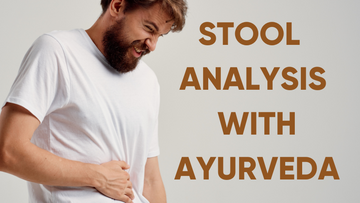
Stool examination is an important investigative process to understand a person's health and disease condition. It is also mentioned in the Ayurveda’s Ashtasthana Pariksha. The factors described under Ashtasthana Pariksha indicate that these are the body parts or metabolic products that will change when a person is sick. These changes can be used to make a diagnosis or to aid in the diagnosis of a disease. Purisha (Stool) changes have been described under various disease conditions in Ayurveda. As a result, a study is planned to compile all such scattered data related to changes in stool in various disease conditions using various Ayurvedic medications.
In Ayurveda, three classics were thoroughly studied, and the descriptions of stool were meticulously collected. These observations were critically analyzed and categorized under specific headings in order to provide the best solution to treat the diagnosed disease.
In Ayurveda, stool examination is mentioned under the eight-fold examination, which includes examinations of;
Nadi (i.e. Pulse)
Mutra (i.e. Urine)
Mala (i.e. Stool)
Jivha (i.e. Tongue)
Drik (i.e. Inspection)
Sparspaha (i.e. Palpation)
Akiti (i.e. Shape, Body Built)
Shabdha (i.e. Voice & Various Sounds)
Why It Is Important To Do Stool Diagnosis
Disease diagnosis
Prognosis
The role of Dosha in vitiation
digestive fire state
Disease stage
Toxins found in food (ama)
Determine your remaining life expectancy (arista Lakshana)
Color variation in stools is common when stools are affected by dosha, and it also depends on the intake of specific medicines or foods. Ayurvedic poop analysis is what your poop says about your health
You've probably gone to the bathroom and noticed an unusual fecal coloring before. While minor variations are generally harmless if you notice your poop is discolored for more than a few days, consult a professional.
So What Does the Color of Your Poop Mean?
Here are some examples of poop colors and some research about what they might mean:
Brown
Any shade of brown is ideal; this, along with the texture of your poop, will indicate how healthy your digestive tract and body are.
Yellow
If your poop is yellow or yellow-brown, you have too much fat in your intestines as a result of malabsorption, an intestinal condition or disease, high Pitta, or poor nutrition.
Red
Red poop indicates that you ate something with red food coloring, that you have hemorrhoids, or that you have bleeding in your digestive system.
White, Pale, or Clay-Colored
This is an indication that your bile ducts are blocked or that you have congestion in your liver/gallbladder. As a result, it is critical to address any underlying causes as soon as possible.
Black
Black poop can be caused by certain foods such as licorice, medications, and supplements. However, if your poop is black for more than a few days, see a doctor because this could be an indication of digestive bleeding. The black stool could indicate old blood from a stomach or upper small intestinal irritation. Consult a doctor right away.
Extremely Green
If your poop is a bright green color, you either have diarrhea and it's green because it's leaving your body too quickly and hasn't fermented properly or you ate a lot of greens or consumed green food dye.
Pale, Clay-Colored Stools
Pale, clay-colored stools may be caused by an insufficient flow of bile from the liver to the gallbladder to the intestine. Bile is responsible for the stool's color. A pale, clay stool indicates that there is no bile.
Stool With A Slippery Presence
You'll recognize it when you see it. As with clay-colored stools, the greasy stool is usually caused by insufficient bile flow from the liver to the bile holding tank, the gallbladder. Remember that bile is what causes the stool to be colored. It's a greenish-yellow fluid with numerous functions, including emulsifying fats and transporting waste. Undigested fat slimes up the stool if the fats are not broken down.
Stool With Blood
Spots of blood on toilet tissue or elsewhere, or streaks of blood in the stool, if persistent, are a good reason to see your doctor. Hemorrhoids are the most common cause of fresh blood in the stool, but there may be other causes.
Stool Covered In Blood
Spots of blood on toilet paper or elsewhere, or streaks of blood in the stool, should be reported to your doctor if they persist. Fresh blood in the stool is most commonly caused by hemorrhoids, but there may be other causes.
Mucus In The Stool
Many people report seeing mucus-like material in their stools. It's clear or whitish, stringy and clingy, and it's wrapped around the stool. The weight and thickness of mucous may have smashed the villi of the intestinal wall. If the mucousy stool persists, the patient should consult a doctor.
An imbalance of the intestinal wall causes mucus in the stool. This could be a medical condition, so consult your doctor if it persists. The mucus in the stool, which appears as a white or clear stringy substance that wraps around the stool, indicates that the intestinal villi have been flattened or clogged by mucus. Coffee, processed foods, stress which we all know, we feel in our guts, and poor digestion, which allows undigested food bits to pass through and irritate the GI lining are all possible causes.
Food Undigested in the Stool
Undigested food is frequently seen in the bowel movements of new clients. The digestion chain is shown below. Assuming that one is eating appropriate food that has been properly spiced, a critical stage in the complicated digestive process begins in the mind. That's correct. When we eat when we are upset, our digestion suffers and we feel it! Eat with a calm, grounded mind, using diaphragmatic breathing, and you will enjoy, appreciate, and digest your meal well.
You now have the means to keep track of your poop. Take a picture of anything unusual in your toilet and save it for your next doctor's appointment. Keep an eye out for any digestive issues. Inspecting your poop gives you the ability to become a master of your digestion, bringing vibrant health into your life. Also for your digestive issues, AADAR has got you backed with Relax & Re-Lax Pro
Poo analysis with Ayurveda is fascinating, to be sure, but it is only one assessment tool AADAR that can help you feel your best. Consider the insights gained when the tongue, poo, pee, sweat, hair, and so on are all carefullyYou can consult your family doctor first, or you can consult your family doctor first, or you can contact our Health Expert or connect us at +919867667699 to obtain the most accurate diagnosis.




